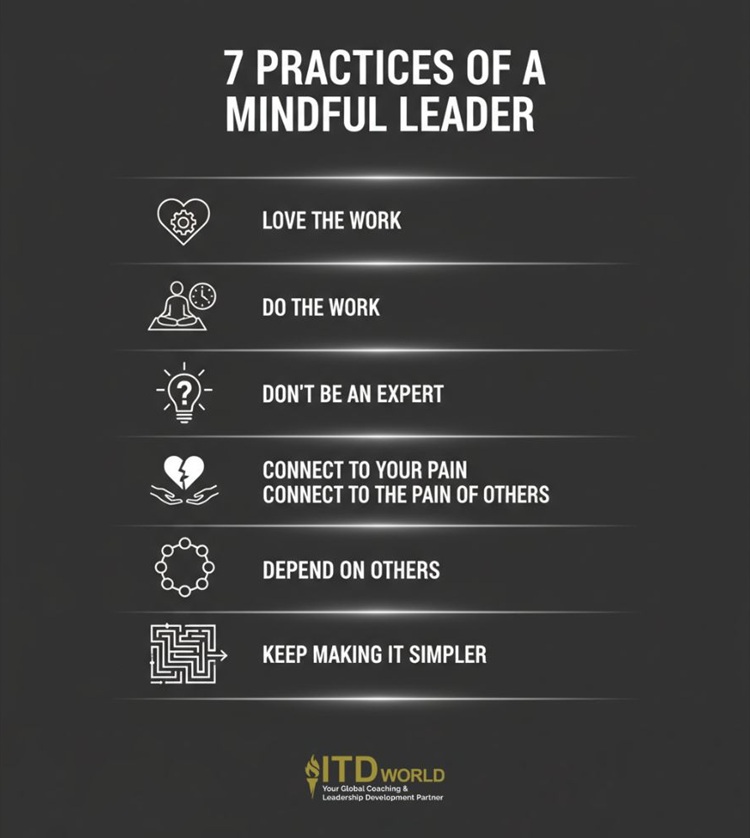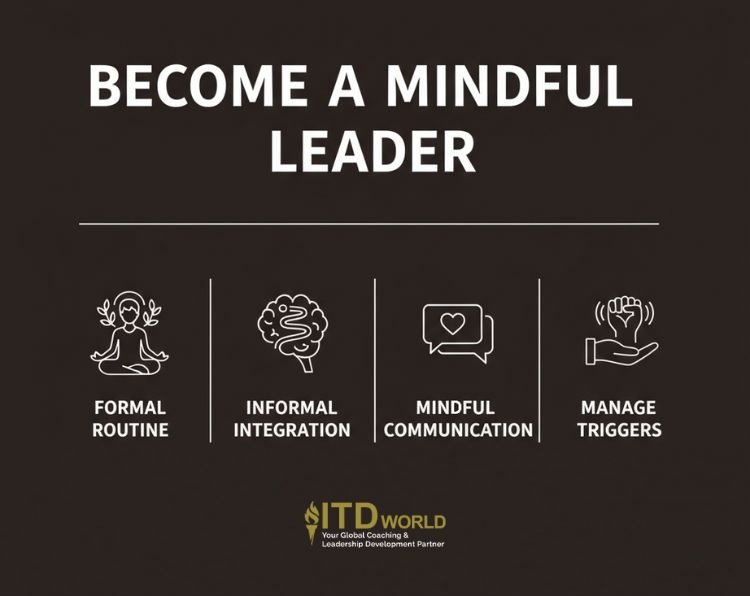Mindful leadership offers a powerful path to effectiveness through the disciplined practice of cultivating presence, clarity, and compassion.
In today’s relentlessly fast-paced business world, leaders are constantly bombarded with distractions, demands, and decisions; no wonder many succumb to reactive behavior and burnout. Mindful leadership presents a solution to this problem. By learning to be present, one becomes better equipped to shape the state of mind – in oneself and in others – leading to greater clarity, better decisions, stronger relationships, more engaged employees, and more cohesive teams.
|
Author: Jonathan M. Pham |
Highlights
- Mindful leadership is a leadership approach centered on cultivating present-moment awareness, non-judgmental observation, and compassion. It’s the disciplined practice of paying attention to one’s internal state and external environment to respond thoughtfully rather than react automatically, enabling leaders to navigate complexity with greater calmness and skill.
- Key qualities of a mindful leader include strong self-awareness, deep empathy, unwavering presence, and genuine compassion.
- In the modern business world, mindful leadership is a core competency that combats widespread workplace stress and burnout. It enhances leadership effectiveness (e.g., through better emotional regulation and clearer decision-making) and drives significant organizational ROI by increasing employee engagement and trust.
- Mindful leadership is cultivated through consistent practices, such as setting aside time for dedicated formal mindfulness (like meditation) and integrating it informally into daily work (like mindful listening). It also involves the interpersonal practices of connecting to one’s own pain and the pain of others and cultivating a “beginner’s mind” (not being an expert) to foster humility and open learning.
What is Mindful Leadership?
Mindful leadership is a leadership approach characterized by cultivating present-moment awareness, non-judgmental observation, and compassionate intention. It is the disciplined practice of paying attention to one’s inner state (thoughts and feelings) and external environment (people and situations) with clarity and focus – so that one may respond thoughtfully rather than react automatically, lead from a place of calmness, and navigate complexity with greater skill and humanity.
Key characteristics of a mindful leader:
- Strong self-awareness
- Deep empathy
- Unwavering presence, and
- Genuine compassion.
- etc.
Example: Let’s say a leader receives unexpected, negative feedback about a key project in a meeting.
- A non-mindful reaction might be immediate defensiveness, interrupting the speaker, or visibly showing frustration, which shuts down further honest dialogue.
- A mindful response involves pausing, taking a breath, acknowledging the information without judgment (“Thank you for sharing that perspective”), and asking clarifying questions to fully understand the concern before deciding on the next step.
| Aspect | Non-Mindful Leadership |
Mindful Leadership
|
| Primary State | Reactive, Distracted, Often Stressed |
Intentional, Present, Calm Under Pressure
|
| Focus | Multitasking, Future Worries, Past Regrets |
Single-tasking, Present Moment Awareness
|
| Listening | Listens to reply, interrupts |
Listens to understand, fully present
|
| Decision Making | Impulsive or Emotion-Driven |
Considerate, Objective, Values-Aligned
|
All in all, the main difference between these two approaches lies in the leader’s internal state and its impact on their external actions.
The Power of Mindful Leadership
Why now?
Leadership is creating a state of mind in others. The difference between being a leader and manager, all due respect to managers, is that leaders have to create states of mind.
Barbara Mikulski
Mindful leadership is rapidly moving from a niche practice to a core competency for navigating the modern business world. The intense pressures of today’s environment – characterized by constant change, uncertainty, digital overload, and the rise of AI – are taking a significant toll on both leaders and their teams.
- Combating widespread stress and burnout
We are facing an epidemic of workplace stress. Gallup reports that employee stress, worry, and sadness have been rising globally for the past decade. That’s where the practice of mindfulness comes into play.
Various research, such as a 2019 study by Reb et al., has demonstrated that mindfulness practices significantly reduce stress levels among leaders, leading to better personal health and improved professional performance.
- Enhancing leadership effectiveness & decision-making
A systematic review in Frontiers in Psychology (2024) confirmed that mindfulness enables leaders to acquire crucial qualities like self-awareness, empathy, and resilience. Furthermore, research published by MIT Sloan Management Review observed up to a 50% improvement in emotional intelligence and regulation in leaders who practiced mindfulness regularly. This translates to clearer thinking and more holistic decision-making, especially under pressure.
- Driving engagement & ROI
The benefits extend to the entire organization. Companies like Google and Intel that have implemented mindful leadership programs report significant increases (around 20-25%) in employee engagement and retention. As noted by Peter Bostelmann, former Chief Mindfulness Officer at SAP, mindfulness training yielded a remarkable 200% ROI for the company, driven by higher loyalty, increased leadership trust, and reduced absenteeism.
Mindfulness has been practiced by global leaders and companies as an efficient way to build effective leadership.
June Borge Doornich, Nord University

Mindfulness based leadership
Mindful leaders in action
Mindfulness is not just an academic or philosophical concept; it’s a practice embraced by some of the world’s most successful leaders – and has contributed to the establishment of various high-performing organizations:
- Marc Benioff (Salesforce): The founder and CEO of Salesforce is a long-time advocate for meditation and has integrated mindfulness spaces (“Mindfulness Zones”) into Salesforce offices globally, recognizing its importance for employee well-being and focus.
- Bill Ford (Ford Motor Company): The executive chairman of Ford has spoken openly about using mindfulness and meditation to navigate the immense pressures of leading the company through challenging times, crediting the practice with enhancing his clarity and resilience.
- Mark Bertolini (Former CEO of Aetna): After a serious personal accident, Bertolini decided to turn to mindfulness and yoga. He then introduced these practices company-wide at Aetna, leading to reported decreases in stress levels and increases in productivity.
Vision + Integrity + Mindfulness + Compassion + Culture of creativity is the spiritual formula of agile leadership in this ever-changing world.
Amit Ray
The 7 Practices of a Mindful Leader
Mindful leadership isn’t simply a state of being; it’s cultivated through consistent, intentional practices. Below is a 7-step framework proposed by Marc Lesser, who is known for integrating Zen principles with corporate leadership. These aren’t steps in a linear process, but rather interconnected disciplines that, when practiced together, allow one to gradually foster presence, clarity, and connection.
-
Love the work
It’s not necessarily about loving every task in your job description, but about embracing the challenging, internal work of cultivating self-awareness, trust, healthy relationships, kindness and compassion. Essentially, one learns to confront the deeper question: “Why am I really here?” and connects their leadership to a sense of purpose or calling.
-
Do the work
Mindfulness is an embodied practice, not an intellectual concept. As such, it requires dedicating regular time to formal “rituals” that anchor one in the present moment and build the capacity for awareness.
- Dedicated practice: Setting aside time for activities like meditation, reflective journaling, or even mindful walking – so as to train the mind to observe thoughts without judgment and to return to a state of calm focus.
- Integrated practice: The goal is then to bring this cultivated sense of presence and awareness into one’s daily interactions and relationships at work.
-
Don’t be an expert
The idea is to cultivate humility and adopt a beginner’s mind. In the realm of human relationships and complex challenges, the ego‘s need to “know it all” is a barrier to connection and learning. Being comfortable with “not knowing” makes it easier for one to listen more deeply and remain open to new possibilities.
Example: Instead of immediately presenting solutions when a team member mentions a problem, a mindful leader practices “not knowing” by asking curious questions like, “Tell me more about how you see the situation”. They demonstrate a genuine desire to learn from the employee’s perspective first.
Read more: Ego in the Workplace – The Hidden ‘Evil’ Behind Team Dysfunctions
-
Connect to your pain
Leaders should have the courage to acknowledge and accept difficulty, both within themselves and in their circumstances, without avoidance or denial. Challenges, after all, are an inherent part of life and leadership; realizing this simple truth is key to fostering resilience and self-compassion.
Example: When facing a significant setback, instead of immediately trying to “fix” it or project strength, a mindful leader takes a moment to acknowledge the problem and their own feelings about it (e.g., disappointment, frustration). Honest self-assessment allows for a more grounded and less reactive response.
-
Connect to the pain of others
This is the practice of extending one’s awareness outward to genuinely feel with others. It starts with developing empathy – the ability to share the feelings of one’s team members. This is crucial because research suggests empathy is likely to decrease as leaders rise in seniority, even as the need for it increases.
Example: When delivering difficult feedback, a mindful leader first takes a moment to consider the other person’s perspective and potential emotional reaction, allowing them to deliver the message with both clarity and compassion.
-
Depend on others
A counter to the myth of the lone, heroic leader, this practice involves recognizing our fundamental interdependence and the need to actively build trust and psychological safety within the team. As showed by Google’s research, the best teams are those where members feel safe, connected, and mutually reliant.
For this purpose, leaders should learn to actively delegate important tasks (showing trust), create opportunities for team collaboration, and be vulnerable enough to ask for help themselves.
-
Keep making it simpler
In a world of overwhelming complexity, the role of a leader is to cut through the noise to maintain clarity and focus on the essential purpose. A scattered, anxious mind tends to breed unnecessary complication; while a calm, present one is likely to find the simplest, most direct path forward.
Example: When feeling overwhelmed by multiple competing priorities, a mindful leader pause and reconnect with their core purpose (“Why are we really here?”), and then prioritize the one or two activities that will truly make the biggest difference.

Principles of mindful leadership according to Marc Lesser’s framework
How to Become an Effective Mindful Leader
Understanding the framework of mindful leadership is the first step; the real transformation comes from integrating these principles into one’s daily habits.
-
Establish a formal routine
Consistency is key here. Dedicating even a small amount of time each day specifically to mindfulness is essential to building the foundational ‘muscle’ of awareness.
How-to: Start with just 5-10 minutes of daily meditation. Use guided meditation apps (like Headspace or Calm) or simply focus on your breath. The goal isn’t to stop thinking, but to notice your thoughts without getting carried away by them. Regular journaling about your thoughts and feelings is another idea worth considering.
Read more: Leadership Self-reflection – Key to Cultivating Excellence
-
Integrate informal mindfulness into your day
You don’t need to sit on a cushion to be mindful. There are countless opportunities to bring present-moment awareness into your routine activities.
Examples:
- Practice mindful walking between meetings – pay attention to the sensation of your feet on the ground instead of mentally rehearsing your next conversation.
- Listen attentively in one-on-ones – give the speaker your absolute, undivided attention without planning your response.
- Even taking three conscious breaths before answering the phone is enough to sow the seed of mindfulness.
-
Practice mindful communication
So much of leadership happens in conversation. Before an important one, set an intention to be fully present. And during the conversation, try to notice when your mind wanders – and gently bring your focus back to the speaker.
-
Manage triggers
Stressful situations often give rise to automatic, unhelpful reactions. Whenever you feel triggered (e.g., by frustrating news or a critical comment), pause for a moment. Take a deep breath. Observe the physical sensation of the emotion (e.g., tightness in your chest), and acknowledge the feeling without judgment (“Okay, this is frustration”).
A simple practice, yet it should allow you to consciously arrive at a more considered, less reactive response.
Read more: Self-coaching – How to Be Your Own Coach

How leaders may cultivate mindfulness
Creating Mindful Leaders: What Organizations Can Do
A supportive ecosystem encourages leaders and makes mindfulness feel like an integral part of the company culture, not just a personal hobby.
- Provide formal training & resources
Organizations should not leave the development of mindfulness to chance. Providing access to high-quality training demystifies the practice and equips the management with practical tools.
Examples:
-
- Conduct workshops on mindfulness basics, stress management, and emotional intelligence.
- Provide subscriptions to mindfulness apps (like Headspace or Calm) as part of the employee wellness program.
- Curate a library of articles and books on mindful leadership.
- Create space for reflection
A culture that values mindfulness must create the time and space for it. This requires looking critically at existing norms around constant busyness.
Examples:
-
- Implement “no-meeting” blocks during the week to allow for focused work and reflection.
- Designate quiet rooms or meditation spaces within the office.
- Encourage leaders to incorporate short “mindful moments” into the start of team meetings to help everyone center themselves before diving into tasks.
- Ensure leadership modeling & sponsorship
The greatest driver of any cultural shift is the behavior of senior leaders. For mindfulness to be taken seriously, it must be visibly practiced and championed from the top.
Example: When a CEO openly shares how their own practice helps them manage pressure, or when senior leaders visibly participate in company-wide wellness initiatives, it sends a message that this is a valued and important aspect of leadership within the organization – a message that is far more impactful than any formal policy.
- Integrate mindfulness into development programs
The idea is to embed the principles and practices of mindful leadership directly into existing leadership development curricula.
Example:
-
- Include modules on emotional regulation, active listening, and leading with presence in programs for new managers.
- Offer executive coaching that specifically revolves around fostering self-awareness and mindful decision-making for senior leaders.

Challenges of Mindful Leadership
- The “busyness” trap
The most frequent objection is simply feeling “too busy.” Leaders are already overwhelmed with demands, and adding mindfulness practice may feel like another burdensome task on an already overflowing to-do list.
Solution: Reframe mindfulness as a detractor, but a performance enhancer that creates more effective time by improving focus and reducing wasted mental energy.
Example: Start incredibly small. Introduce micro-practices like taking three conscious breaths before each meeting or dedicating the first two minutes of your commute to simply noticing your surroundings without judgment. These small acts, over time, will build the muscle of presence without requiring significant time blocks.
- Skepticism & cynicism
In some corporate cultures, mindfulness may be perceived as “fluffy,” lacking in practical application, or disconnected from the “real work” of driving business results. Colleagues or even senior leaders might be cynical about its value.
Solution: Focus on the data and practical benefits. The important thing is to avoid overly spiritual or abstract language; instead, emphasize the science-backed business outcomes discussed earlier – i.e. improved emotional regulation, better decision-making under pressure, reduced stress, and increased employee engagement.
Example: When introducing the concept to your team, try to frame it in practical terms: “We’re going to try a brief focus exercise at the start of our meetings to help us minimize distractions and make our time together more efficient.”
- The perceived conflict with performance
A culture obsessed with constant action and immediate results can make the intentional pause required for mindfulness seem counterintuitive or even lazy. Leaders may feel pressure to always appear busy and decisive.
Solution: Embrace the “Slow down to speed up” principle. By taking a moment to pause and gain clarity, leaders prevent costly mistakes and make better, faster decisions in the long run.
Read more: 7 Leadership Mistakes to Avoid – From Failure to Success
Mindful Leadership Quotes
Check out a full list of quotes about mindfulness here!
Rule your mind or it will rule you.
Horace
Until you make the unconscious conscious, it will direct your life.
Carl Jung
Mindful leadership keeps you cool and energetic in any situation, so that you can make the best possible decisions.
Amit Ray
Unless you challenge yourself, you cannot grow. Mindful leadership is the art of growing by challenging the physical, mental, emotional, and spiritual imposed limits on the self.
Amit Ray
Leadership grows like tall trees. It needs both toughness and flexibility – toughness for accountability – flexibility to adapt changes with a compassionate & caring heart for self and others.
Amit Ray
The moment you become truly aware of your automatic behaviours, something magical is about to happen.
Rúna Magnúsdóttir
Mindfulness helps leaders to constantly be aware of the culture they envision and to align their thoughts, words and actions with that desired culture.
Kathirasan K
You cannot manage other people, unless you manage yourself first.
Peter Drucker
The best way to capture moments is to pay attention. This is how we cultivate mindfulness. Mindfulness means being awake. It means knowing what you are doing.
Jon Kabat-Zinn
You can evaluate the quality of your authority by looking deeply to see if compassion is the foundation of your leadership.
Thich Nhat Hanh
Aimlessness does not mean doing nothing. It means not putting something in front of you to chase after.
Thich Nhat Hanh
Mindful Leadership Books
- Mindful Leadership: The 9 Ways to Self-Awareness, Transforming Yourself, and Inspiring Others – by Maria Gonzalez
Key themes: Practical mindfulness tools for leaders to cultivate presence, clarity, and compassion.
- The Mindful Leader: 7 Practices for Transforming Your Leadership, Your Organisation and Your Life Book – by Michael Bunting
Key themes: Integrates mindfulness with leadership development, emphasizing integrity, self-awareness, and impact.
- Seven Practices of a Mindful Leader: Lessons from Google and a Zen Monastery Kitchen Book – by Marc Lesser
Key themes: Combines Zen principles with corporate management, offering actionable practices for conscious leadership.
- Mindfulness Meditation for Corporate Leadership and Management – by Amit Ray
Key themes: Inner transformation, emotional intelligence, and resilience in high-pressure environments.
- Search Inside Yourself – by Chade-Meng Tan
Key themes: Developed at Google, the book explores the role of emotional intelligence and mindfulness in personal and professional growth.

Mindful Leadership Training: How ITD World Can Help
At ITD World, we specialize in helping leaders cultivate the human-centric skills that are foundational to mindful leadership. Our programs are designed to develop the self-awareness, emotional regulation, and presence needed to lead effectively in today’s demanding environment.
- Executive coaching: Our one-on-one coaching provides a confidential space to explore your internal landscape with the help of an expert coach.
- Coaching certification programs (CCMP, CCMC): These programs equip leaders with the core coaching skills – such as deep listening and powerful questioning – that are essential for mindful communication and growing others.
- Leadership workshops & retreats: We offer targeted programs focused on Emotional Intelligence (EQ), resilience, and building psychological safety, all of which are cultivated and enhanced through mindful leadership practices.
Mindful leadership coaching
Ready to lead with greater clarity, presence, and impact? Contact ITD World today to learn how our solutions can help!
Other resources you might be interested in:
- Emotional Intelligence in Leadership: How to Lead with Heart
- Servant Leadership: For Those Who Would Like to Become First
- Situational Leadership: Guide to Implementation
- 12 Leadership Coaching Topics to Drive Lasting Transformation
- Life Management: A Holistic Guide

